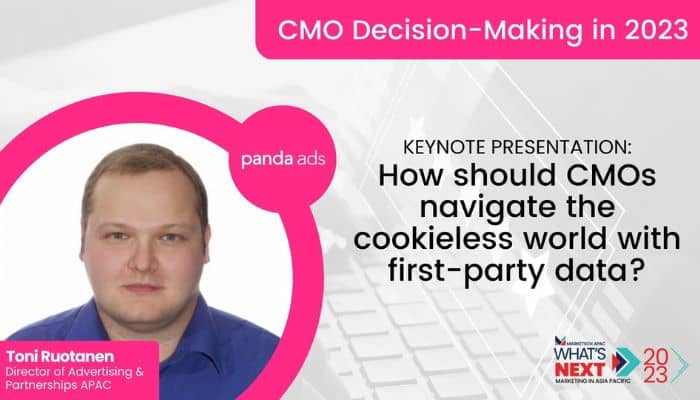It’s been years since markets have discussed using first, second, and third-party data in the digital world. We have also been faced with the announcement of no tracking on iOS and the delayed implementation of cutting third-party cookies by Google to 2024. Marketers have been approached by various data agency partners and customer data platform (CDP) partners such as Insider, Tealium, Adobe, Sitecore, and more to sell their data platform solutions.
Unfortunately, I have seen that with much fanfare, many markets, after buying into the solutions provided by data agencies or platform providers, fail to make full use of the investment they have made in those platforms. Those CPD platforms become half-baked into the client’s data ecosystem or sit as an orphan that no one knows how to maximise their use. Now that the selling part is done, what needs to happen is to have a true partner, internal or external, that has to orchestrate all the data you have in harmony to bring the most out of it.

The Ensemble: Overview of Your First-Party Data
It’s a misnomer that markets think only in silos and treat their first-party data as the data gathered from their paid and owned media. While it’s doable, capturing the data from earned media and putting it into your CDP is challenging, as you don’t have complete control of the user-generated content.) There is a wealth of data across all platforms that each marketer has- paid media data, organic data, customer CRM data, loyalty program data, and more. In short, you have massive amounts of consumer data that interact with your company’s properties in various ways. Two industries stood out for having the most first-party data across all industries: banking and finance, as well as travel and hospitality.
The issue we have on hand right now is that marketers fail to do a collective overview of all the first-party data they have been collecting via various channels. They jump right into selecting a CDP platform only for paid media. This is the most common mistake that I see marketers make. Your CDP is more than an enhanced version of your GA4, Adobe Analytics, Google Campaign Manager, or Looker. Without the proper assembling, you would have a CDP platform that costs you millions but brings nothing in return in revenue.
Overtune: Setting the Stage
After analysing all the available data, you must set the stage to make them work for you. You must have both marketing and business data plugged into the system. Otherwise, you will have data only collected from systems such as Sitecore or Salesforce or from media activities from media channel connectors into your CDP system. You need to have both the front-end data (marketing data collected) and the backend data (customer, sales, and CRM data) join via the CDP to allow data segmentation and predictive modelling. You need to include both sides of the information to maximise your media efficiency and drive home results to prove to your CFO the return on investment on your CDP platform.
Intermission: Operational Excellence
This is the section where I see most marketers fall off a cliff and fail to ensure their CDPs. After plugging in your media data and your CRM/Customer Data, you need to start utilising the CDP platforms for what they should do – Predictive Modeling and Customer segmentation. With this, you can begin to orchestrate your media activities and segment the audience you have been collecting. With the CDP, it will help you exponentially increase the power of your first party data beyond standard remarketing, which, unfortunately, I see too many marketers end up using a CDP platform only for the sake of remarketing. With your CDP’s proper predictive modelling and segmentations, you can adequately leverage your data for future customer engagement, whether paid or owned media. You can create bespoke creative messaging and landing pages for different audiences based on your segmentation and predictive analysis from the CDP platform.
Finale: Results Framework
Your C-Suite will start questioning the investment in your CDP solutions. Now, it’s the final chapter to prove the return on investment in your paid and owned media activities and how they link it to the business metrics rather than just the marketing metrics. Ultimately, revenue is what all businesses seek, rather than simply looking at how much media efficiency you drive through CPC, CPM, or CPV. Those metrics are important, but they won’t bring you home as the hero of your company. You need to be able to quantify how your CDP platform helps you drive the actual business outcomes for your company.
Many marketers are now panicking and need help managing the first party data once the cord of the cookies is finally cut by Google. It’s the best and worst times to start looking at your current data collection systems, whether in Looker, Adobe, GA4, or even as simple as using Google Campaign Manager. There is still time for you to transition from a basic analytics or cookie collection platform to a real CDP. Media and Data Scientists are here to help translate a very technical aspect of CDP into a layman’s term and help you connect the dots internally between your CEO and the CTO. This is a must for an agency, be it a media, data, creative, social, or performance agency, to perform well beyond the cookie-less world. You need to have a professional expert who knows your business needs and understands the challenges of your current data privacy and the data ecosystem. With the proper orchestration, you can make all your first party data dance in harmony and bring impactful revenue to your business.

This article is written by Antony Yiu, chief executive officer at PHD Hong Kong
The insight is published as part of MARKETECH APAC’s thought leadership series under What’s NEXT 2023. What’s NEXT 2023 is a multi-platform industry initiative which features marketing and industry leaders in APAC sharing their marketing insights and predictions for the upcoming year.

















